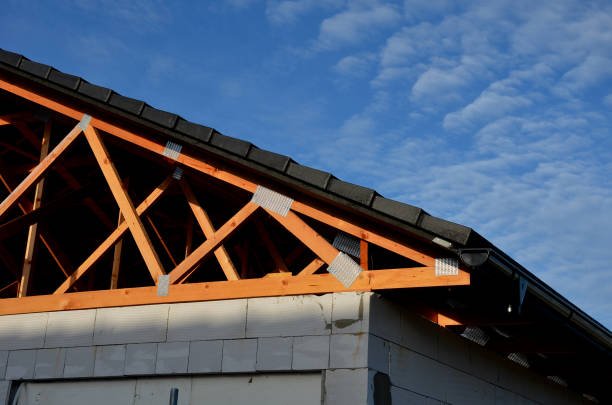When it comes to deciding between a gable vs. hip roof, many homeowners find themselves weighing aesthetics, functionality and climate considerations before making the final call. A roof isn’t just a finish on your home—it plays a major role in structure, durability, energy efficiency and curb appeal. In this post we’ll explore what sets gable and hip roofs apart, what you should keep in mind when selecting one, and how to determine which approach fits your home and budget.
What is a Gable Roof?
A gable roof features two sloping sides meeting at a ridge, forming a triangular end wall (or “gable”). This triangular shape creates a recognizable silhouette and has long been a popular choice in residential architecture. The simplicity of the design means fewer structural components, easier framing, and in many cases lower cost. The steep slopes help with shedding rain and snow, and the triangular end walls give extra attic space and ventilation potential.
Pros of a gable roof:
- More attic space: The steep slopes create a high peak, offering room for storage or even future conversion.
- Cost-effective: Fewer roof planes and simpler framing generally make the build less expensive.
- Effective in snow/rain: The slope helps quickly move precipitation off the roof, reducing risk of water pooling or ice build-up.
- Classic look: The triangular form gives timeless styling and pairs well with many home types.
Cons to consider:
- Wind vulnerability: In high-wind zones or hurricane-prone regions, the flat gable ends can act like sails and may pose a higher risk.
- Less refined lines: Depending on design, the sharp triangle may feel more “traditional” than modern or low-profile.
- Attic space trade-off: While you gain volume, the steep roof may limit usable headroom at the outer edges.
What is a Hip Roof?
A hip roof slopes inwards on all four sides (or all sides in the case of a pyramid hip), so there are no vertical end walls like with a gable. The result is a more compact, symmetrical shape that distributes loads across all sides—making it inherently more stable in many cases. Ideal for areas with strong winds or exposed situations, hip roofs bring certain structural and weather-performance advantages.
Pros of a hip roof:
- Excellent wind resistance: Because all sides slope downwards, there are fewer flat vertical surfaces for wind to catch.
- Balanced aesthetic: The uniform eaves around all sides lend a polished, cohesive look.
- Potential energy benefit: With less attic volume and more compact framing, heating/cooling loads can sometimes be lower.
- Sound structural choice: The even distribution of weight improves overall stability and durability.
Cons to consider:
- Cost and complexity: More roof planes, more framing and more complex joinery can drive up materials and labor cost.
- Reduced attic space: The inward slopes reduce headroom near the eaves, so usable attic/storage space might shrink.
- Design constraints: If you are trying to maximize loft or attic conversion space, a hip roof may limit options.
Side-by-Side Comparison
Here’s a quick snapshot of how the two roof types align across key factors:
| Factor | Gable Roof | Hip Roof |
|---|---|---|
| Construction cost | Generally lower (simpler framing) | Typically higher (more complex) |
| Attic/loft space | More volume, easier access | Less headroom, smaller usable space |
| Wind resilience | Less ideal in high‐wind zones | Better suited for windy/exposed sites |
| Design flexibility | Many variations (cross-gable, Dutch) | Fewer stylistic variants |
| Visual appeal | Traditional, dramatic lines | Symmetrical, refined look |
| Best climate match | Snow/rain regions where shedding is key | Hurricane/wind‐prone zones |
Which One Should You Choose?
Selecting between a gable vs. hip roof really comes down to balancing your priorities: your budget, local climate, desired attic/loft use, and the look you want for your home.
- Climate: If you live in an area that experiences heavy snowfall or you simply want efficient shedding of rain and snow, a gable roof may be the better fit. On the other hand, if your home is in a high-wind or hurricane-prone region, a hip roof offers superior resilience.
- Budget: For homeowners aiming to build or replace a roof under budget constraints, the simpler framing of a gable roof often wins out. If budget allows and durability/appearance matter more, investing in a hip roof might make sense.
- Attic/Loft Use: If you plan to use the under-roof space for storage or a future living area, a gable roof can provide more usable volume and headroom.
- Aesthetic & Architecture: Your home’s architectural style should also guide the decision. A modern house with clean lines may pair better with a symmetrical hip roof, while a classic or farmhouse style may naturally support a gable roof.
- Maintenance & Longevity: Both roofs require maintenance, but the simpler design and fewer joint points of a gable roof can make maintenance a bit easier. On the flip side, the increased stability of a hip roof may mean fewer issues over the long run in certain conditions.
Final Thoughts
Choosing the right roof type isn’t just a matter of picking what looks best—it’s a strategic decision that impacts the home’s performance, longevity and value. When comparing the two: gable vs. hip roof, there’s no one‐size‐fits‐all answer. It’s about what fits your home, your climate and your budget.
At the end of the day, whatever roof style you select, quality of materials and skilled installation matter just as much as the shape. When you’re ready to explore options and ensure the job’s done right, trust the expertise of Asbury Home Improvements for professional advice, excellent workmanship and peace of mind.
